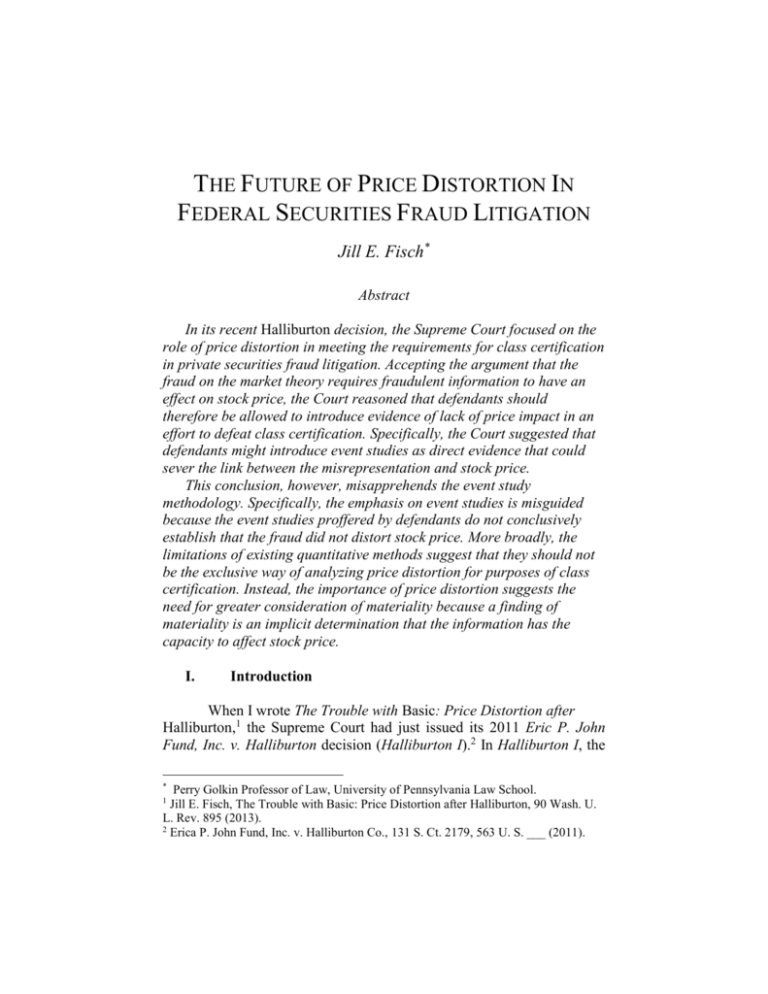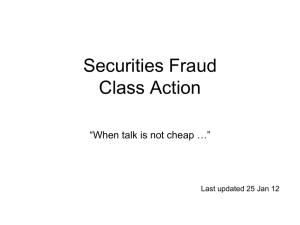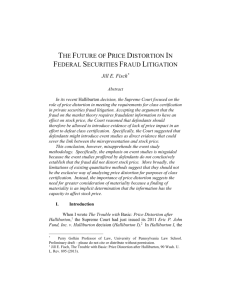Basic at Twenty
advertisement

THE FUTURE OF PRICE DISTORTION IN FEDERAL SECURITIES FRAUD LITIGATION Jill E. Fisch* Abstract In its recent Halliburton decision, the Supreme Court focused on the role of price distortion in meeting the requirements for class certification in private securities fraud litigation. Accepting the argument that the fraud on the market theory requires fraudulent information to have an effect on stock price, the Court reasoned that defendants should therefore be allowed to introduce evidence of lack of price impact in an effort to defeat class certification. Specifically, the Court suggested that defendants might introduce event studies as direct evidence that could sever the link between the misrepresentation and stock price. This conclusion, however, misapprehends the event study methodology. Specifically, the emphasis on event studies is misguided because the event studies proffered by defendants do not conclusively establish that the fraud did not distort stock price. More broadly, the limitations of existing quantitative methods suggest that they should not be the exclusive way of analyzing price distortion for purposes of class certification. Instead, the importance of price distortion suggests the need for greater consideration of materiality because a finding of materiality is an implicit determination that the information has the capacity to affect stock price. I. Introduction When I wrote The Trouble with Basic: Price Distortion after Halliburton,1 the Supreme Court had just issued its 2011 Eric P. John Fund, Inc. v. Halliburton decision (Halliburton I).2 In Halliburton I, the * Perry Golkin Professor of Law, University of Pennsylvania Law School. Jill E. Fisch, The Trouble with Basic: Price Distortion after Halliburton, 90 Wash. U. L. Rev. 895 (2013). 2 Erica P. John Fund, Inc. v. Halliburton Co., 131 S. Ct. 2179, 563 U. S. ___ (2011). 1 Supreme Court decided very little – its cryptic statement that loss causation and reliance were two separate concepts did not engage with the key question of whether the antiquated concept of reliance should continue to form a meaningful component of federal securities fraud jurisprudence.3 More importantly, as I argued, the Court in Basic Inc. v. Levinson4 premised its fraud-on-the-market (“FOTM”) presumption5 on a concept of price distortion that had never been fully articulated.6 The Court determined that the legal element of reliance could be presumed on the basis that fraudulent misrepresentations distort securities prices.7 Subsequent commentary revealed that this concept was problematic.8 The Court subsequently decided Amgen Inc. v. Connecticut Retirement Plans and Trust Funds.9 Amgen offered the Court the opportunity to consider the relationship between price distortion and materiality or, more generally, the role price distortion plays in the FOTM presumption. The Court resisted the temptation, and declined to reconsider Basic. Rather than engaging in a detailed analysis of the role of materiality in federal securities fraud litigation, the Court ruled, on procedural grounds, that plaintiffs were not required to prove materiality at the class certification stage.10 The significance of price distortion was not, however, laid to rest. After Amgen, the defendants in the Halliburton case renewed their attempt to defeat class certification on the basis that price distortion, See id. at 2186 (“The fact that a subsequent loss may have been caused by factors other than the revelation of a misrepresentation has nothing to do with whether an investor relied on the misrepresentation in the first place, either directly or presumptively through the fraud-on-the-market theory. Loss causation has no logical connection to the facts necessary to establish the efficient market predicate to the fraudon-the-market theory.”). 4 Basic Inc. v. Levinson, 485 U. S. 224 (1988). 5 See id. (adopting fraud-on=the-market presumption of reliance). 6 Fisch, supra note 1 at 916 (explaining Basic as adopting a “market-based” approach to federal securities fraud). 7 Basic, 485 U.S. at 242–43. 8 See Fisch, supra note 1 at 912 (citing criticisms of the Basic decision and its reasoning). 9 Amgen Inc. v. Connecticut Retirement Plans and Trust Funds, 568 U. S. _133 S. Ct. 1184 (2013). 10 Id. at 1199 (“Because a failure of proof on the issue of materiality, unlike the issues of market efficiency and publicity, does not give rise to any prospect of individual questions overwhelming common ones, materiality need not be proved prior to Rule 23(b)(3) class certification.”). 3 2 which they termed price impact, was a critical component of the FOTM presumption of reliance under Basic.11 In Halliburton II, decided last term, the Supreme Court agreed.12 Although the Court rejected the petitioners’ effort to have Basic overruled, the Court concluded that price impact was a component of the reliance requirement13 and that defendants could therefore rebut the FOTM presumption by demonstrating the absence of price impact.14 The Supreme Court’s reasoning on this point is theoretically correct. Basic’s presumption of reliance depends upon the fact that misinformation distorts stock price and on the assumption that, in the absence of fraud, the stock price at which the plaintiffs traded would have been different from the price at which plaintiffs actually traded.15 In colloquial terms, the market-based harm identified in Basic, and for which an FOTM claim provides a remedy, is the harm of trading at a distorted stock price.16 No distortion – no claim.17 The challenge posed by defendants’ argument is twofold. First, price distortion, as I have previously explained, is not the same as price impact.18 Second, price distortion, although conceptually logical, is a pragmatically illusive concept. There is no reliable empirical basis for determining the price at which a security would have traded in a counterfactual world in which no fraud had occurred. Moreover, the Court’s suggestion, in Halliburton II, that defendants can use event studies to prove the absence of price impact19 is not methodologically sound. The solution is to reject the temptation to allow flawed empirical methods to dominate the analysis. Because the empirical methodology is not appropriate, the current focus on event studies is misguided. Moreover, it is unnecessary. 11 See Petition for Writ of Certiorari, at 4, http://sblog.s3.amazonaws.com/wpcontent/uploads/2013/10/No.-13-317-Brief-in-Opposition.pdf. 12 Halliburton Co. v. Erica P. John Fund, Inc., __ U.S. __, 134 S. Ct. 2398 (2014). 13 Id. at 2416 (“Under Basic’s fraud-on-the-market theory, market efficiency and the other prerequisites for invoking the presumption constitute an indirect way of showing price impact.”). 14 Id. at 2417. 15 Basic Inc. v. Levinson, 485 U. S. 224, 244 (1988). 16 Fisch, supra note 1, at 916. 17 Id. (explaining that market-based approach results in a measure of damages based on the amount of price distortion attributable to the fraud). 18 See id. at 923–24. 19 See Halliburton II, 134 S.Ct. at 2415. 3 Federal securities fraud already has a tool for evaluating price impact. That tool is the element of materiality. A determination that information has the capacity to affect stock price is implicit in a finding of materiality.20 This essay argues that existing quantitative methods are inferior to an analysis of materiality. As a result, the essay argues that the Court’s analysis in Amgen was incorrect and that materiality rather than reliance should be the focus of the Court’s inquiry at class certification. This essay begins in Part II by clarifying the role of price distortion in FOTM and explaining the distinction between price distortion and price impact. In Part III, the essay explains why an event study showing that a misrepresentation did not result in a statistically significant abnormal return does not establish the absence of price distortion and does not, therefore, rebut the FOTM presumption. Part IV discusses the implications of this analysis. In particular, the essay concludes that the Basic presumption should be predicated on a showing of materiality and considers the relationship between that showing and the concept of price distortion discussed by the Court in Halliburton II. II. The Role of Price Distortion In Halliburton II, the Court reiterated the premise upon which Basic based its presumption of reliance: misinformation distorts prices in the public capital markets.21 As the Court explained, without price impact, there is no reason to presume class-wide reliance on the misrepresentations by relying on the market price, because nothing establishes that the misrepresentations were even reflected in that price.22 The analysis is exactly right. In Basic, the Court reasoned that fraudulent information distorts security prices.23 In essence, a security trades at a different price in a market affected by fraud than in a market in which that fraud is absent. 20 See Basic, 485 U.S. at 231–32 (citing TSC Industries, Inc. v. Northway, Inc., 426 U. S. 438, 449 (1976) (“[T]o fulfill the materiality requirement ‘there must be a substantial likelihood that the disclosure of the omitted fact would have been viewed by the reasonable investor as having significantly altered the 'total mix' of information made available.’”)). 21 Halliburton Co. v. Erica P. John Fund, Inc., __ U.S. __, 134 S. Ct. 2398 (2014). 22 Halliburton II, 134 S.Ct. at 2416. 23 Basic, 485 U.S. at 246 (“Recent empirical studies have tended to confirm Congress' premise that the market price of shares traded on well-developed markets reflects all publicly available information, and, hence, any material misrepresentations.”). 4 Basic’s analysis was somewhat opaque, leaving subsequent courts to struggle with developing the components of fraud on the market.24 First, Basic suggested that its analysis depended critically on market efficiency.25 This led subsequent courts to devote considerable effort to evaluating the extent to which the particular market in which a security traded was sufficiently efficient to justify the Basic presumption.26 In recent cases, many courts have considered expert testimony attempting to assess the degree of efficiency in the market for a specific security.27 This emphasis on market efficiency is a mistake.28 Markets need not be efficient for prices to respond to and reflect fraudulent information.29 Indeed, prices respond to information in most markets, whether or not they can be characterized as efficient.30 In addition, Basic’s presumption is based on the response of stock price to a particular information event – the fraudulent disclosure that is the subject of the litigation. While the efficiency of the market may suggest, as a general matter, prices respond to information, it does not directly answer the question of whether market price responded to and incorporated the fraudulent disclosure itself.31 Similarly, commentators, including the petitioners in Halliburton II, criticized Basic as inconsistent with modern developments in 24 See, e.g., Donald C. Langevoort, Basic at Twenty: Rethinking Fraud on the Market, 2009 Wis. L. Rev. 151, 161 (describing “confusion” generated by the way the Basic plurality opinion was written). 25 Id. 26 See, e.g., Cammer v. Bloom, 711 F.Supp. 1264 (D.N.J. 1989). 27 See, e.g., In re Federal Home Loan Mortgage Corp., 281 F.R.D. 174 (S.D.N.Y.2012); McIntire v. China MediaExpress Holdings, Inc., (S.D.N.Y. 2014). 28 See Halliburton Co. v. Erica Fund, Brief of Law Professors as Amicus Curiae dated Jan. 2014, at 4 (arguing that Basic’s use of market efficiency to show reliance is a “mistake and counterproductive”). 29 See Donald C. Langevoort, Theories, Assumptions, and Securities Regulation: Market Efficiency Revisited, 140 U. Pa. L. Rev. 851, 899 (1992) ("[t]he only important question is whether the price was distorted," not "determining what is or is not a truly efficient market"). 30 See, e.g., James Cox, Fraud on the Market After Amgen, 9 Duke J. Const. L. & Pub. Pol. 101 (Dec. 11, 2013), available at, SSRN: http://ssrn.com/abstract=2366450 (Cox, After Amgen) (observing that prices of small cap stocks, that trade in what is generally understood as inefficient markets, respond to information); Fisch, supra note 1 at 913 n. 120 (arguing that information affects prices even in markets that are not efficient). 31 See, e.g., In re Merck & Co. Sec. Litig., 432 F.3d 261 (3d Cir. 2005). 5 economics.32 First, they argued that Basic is undercut because empirical studies demonstrate that the capital markets are not fundamentally efficient, meaning that a stock’s trading price is not an accurate reflection of its intrinsic value.33 Second, they identified the growing body of behavioral economics suggesting that many market participants - including noise traders and algorithmic traders, for example -- do not engage in information-based trading.34 With respect to the first critique, it is certainly true that the concept that market prices reflect fundamental or intrinsic value is highly contested.35 Indeed, it is unclear that current empirical methods contain a sufficient robust concept of value to test the proposition.36 With respect to the second critique, although noise traders and others may not trade in response to information developments, information plays a critical role in the decisions of most investors.37 Hedge funds, for example, exist to uncover and exploit informational advantages.38 In addition, although market developments have changed securities trading from the time of the Basic decision, those developments have greatly facilitated the capacity of the market to respond to information. The information environment post-Basic has, through the use of technology, the internet, and social media, become richer and more responsive.39 As a result, the analysis in Halliburton II suggests a conceptually cleaner evaluation of an FOTM claim in which the critical question 32 See, e.g., Brief for Petitioners, at 15–16. See Brief for Petitioners at 16, (explaining that “overwhelming empirical evidence” now “suggests that capital markets are not fundamentally efficient.” Lev & de Villiers, Stock Price Crashes and 10b-5 Damages: A Legal, Economic and Policy Analysis, 47 Stan. L. Rev. 7, 20 (1994)). 34 Brief for Petitioners at 20. 35 See, e.g., Richard Thaler, Markets Can be Wrong and the Price is Not Always Right, Fin. Times Aug. 4, 2009 (explaining the confusion between information efficiency and fundamental value efficiency). 36 See James D. Cox, Understanding Causation in Private Securities Lawsuits: Building on Amgen, 66 Vand. L. Rev. 1719, 1728 (2013) (Cox, Building on Amgen) (explaining that “there are no reliable models for determining the ‘correct’ price of a security”). 37 See Brief of Securities Law Scholars as Amicus Curiae, at 9-10 (describing manner in which information influences investors’ trading decisions). 38 See, e.g., Jill E. Fisch, Confronting the Circularity Problem In Private Securities Litigation2009 Wisc. L. Rev. 333, 346-47 (2009) (explaining that some hedge fund are information-based traders). 39 See, e.g., Heather Traeger, &Kris Easter, Use of Social Media in Private Fund Offerings: Perks, Perils and Privacy, 13 J. Bus. & Sec. L. 143 (2013). 33 6 should be whether the fraudulent information affected stock price at the time at which the plaintiffs traded. Importantly, the requirement that stock price be distorted, as I have argued elsewhere, is not the same as price impact.40 There are a variety of circumstances in which the release of fraudulent information may not have any immediate effect on stock price even though, in the counterfactual world in which truthful disclosure is made, the stock price would have been different.41 The most common of these circumstances is when a misrepresentation confirms market expectations or falsely conceals an adverse change or development. In such a case, the fraudulent statement is unlikely to generate any market reaction at all. Nonetheless, the information distorted the stock price because, in the counterfactual world in which the defendant had disclosed accurately, the market would have responded to the information conveyed by that disclosure.42 Basic itself is such a case.43 Plaintiffs claimed that Basic lied by falsely denying the existence of merger negotiations.44 The price of Basic’s stock, at the time that the plaintiffs traded, was arguably distorted because the market was unaware of the merger negotiations. In other words, by falsely denying the existence of the negotiations, Basic, prevented that information from being incorporated into market price. Had those negotiations been disclosed, the price of the stock would arguably have been higher. The plaintiffs’ were injured then, in the amount of the difference between Basic’s actual price, and the price at which the stock would have traded absent the fraud.45 40 Fisch, supra note 1, at 923-24. See id. at 918-20 (providing examples). 42 See, e.g., In re Pfizer Inc. Sec. Litig., 936 F. Supp. 2d 252, 264 (S.D.N.Y. 2013) ("a misstatement may cause inflation simply by maintaining existing market expectations") (citation omitted); Schleicher, 618 F. 3d at 683-84 (explaining that a public misrepresentation may impact the stock price by causing the price to rise or stopping it from declining). 43 See Basic Inc. v. Levinson, 485 U.S. 224, 231-232 (1988). 44 Basic at 228. 45 See Fisch, supra note 1, at 917. Justice Blackmun was aware of these potential effects of Basic’s reasoning on the appropriate calculation of damages, but agreed to defer the issue at the request of Justice Stevens. See A.C. Pritchard, Stoneridge Investment Partners v. Scientific-Atlanta: The Political Economy of Securities Class Action Reform, 2008 CATO SUP. CT. REV. 217, 221 nn.15 & 16 (citing Harry Blackmun, Conference Notes, Basic v. Levinson, No. 86-279 (November 4, 1987) (Harry A. Blackmun Collection, Library of Congress) & Letter from Harry A. Blackmun to William J. Brennan, Jr., No. 86-279, Basic v. Levinson (Jan. 15, 1988) ). 41 7 A second example involves multiple or bundled disclosures.46 Many, if not most, corporate disclosures involve more than one discrete piece of information. Each piece of information, if it is material, is likely to have an effect on stock price. Consider, for example, an issuer that releases both good news – a promising new product in development and bad news – its most recent earnings were below analyst expectations. To the market, the good and bad news may cancel each other out, resulting in no direct impact on stock price. Now imagine that the news about the promising new product is false. Had that information not been coupled with the earnings release, the stock price would have fallen. Thus the trading price was distorted by the fraudulent disclosure, but the statement did not have a price impact. Importantly, the price distortion at the core of FOTM focuses on whether stock price distorted at the time that the plaintiff trades. I have described this elsewhere as ex ante price distortion.47 Whether the stock price responds when the fraud is revealed to the market is a distinct question, which I have termed ex post price distortion.48 Ex ante and ex post price distortion are related, but not equivalent concepts.49 The original fraudulent statement and the corrective disclosure in securities fraud litigation can occur months apart. During that period of time, both market and firm-specific developments can affect the significance of a given factual statement so as to increase or decrease its effect on stock price.50 As a result, the reaction of the stock price to the corrective disclosure does not necessarily indicate the degree to which the original statement affected the stock price.51 46 See Fisch, supra note 1, at 919-20. See id. at 924. 48 Id. 49 See Petitioners brief at 51 (equating analysis of price impact for purposes of loss causation and at class certification). The petitioners had previously argued to the Court that the analysis was the same – an argument that the Court rejected in Halliburton I; see also Erica P. John Fund, Inc. v. Halliburton Co., 131 S. Ct. 2179, 2186 (2011). 50 See, e.g., Patrick J. Coughlin et al., What’s Brewing in Dura v. Broudo? The Plaintiffs’ Attorneys Review the Supreme Court’s Opinion and Its Import for Securities-Fraud Litigation, 37 Loy. U. Chi. L.J. 1, 26 (2005) (explaining how defendants can, through prior disclosures, “walk down” the stock price so as to minimize the price impact of a negative corrective disclosure). 51 See, e.g., Frederick C. Dunbar &Arun Sen, Counterfactual Keys to Causation and Damages in Shareholder Class-Action Lawsuits, 2009 Wisc. L. Rev. 199, 1214 (“In some circumstances it is possible that a timely disclosure would have been material-47 8 Consider again, the example of Basic.52 Assume that, as was the case, on October 21, 1977, Basic falsely denied that it was engaged in merger negotiations.53 On December 20, 1978, Basic and Combustion Engineering announced that they had signed a merger agreement.54 Imagine that, the next day, Basic announced that it had, in fact, been engaged in merger negotiations since before October 21, 1977, and that its prior denial of such negotiations was false. It is highly unlikely that this announcement would affect the stock price – the existence of prior merger negotiations was rendered irrelevant to Basic’s stock price by the subsequent announcement of the merger.55 Similarly, the price impact of a corrective disclosure may be greater than the amount of the original price distortion.56 Among other things, the corrective disclosure reveals not just the falsity of the prior statement but questions about management integrity or internal controls.57 The market may view those questions as more significant than the misstatement itself. The corrective disclosure may also reveal the potential for subsequent litigation, leading the market to reflect that litigation risk in its price reaction.58 Thus the presence of price impact at the time of a corrective disclosure – loss causation – does not establish that stock price was distorted at the time of the fraud. For the same reason, an event study that fails to establish loss causation does not prove that the original misstatement did not affect the stock price. As the Court’s opinion in Halliburton I correctly concluded, ex ante and ex post price distortion are conceptually distinct.59 that is, would have caused a measurable price drop--while the untimely disclosure does not cause a price drop due to changes in economic conditions.”). 52 Basic Inc. v. Levinson, 485 U.S. 224, 231-32 (1988). 53 Id. at 228 n.4. 54 See id. (reporting Basic’s public announcement of the merger agreement). 55 Critics might argue that the merger announcement itself constituted Basic’s corrective disclosure, but of course the fact that the two companies eventually merged would not, by itself, disclose that Basic’s previous denial was, at the time it was made, false. 56 See also Barbara Black, Reputational Damages in Securities Litigation, 35 J. Corp. L. 169, 173 (2009) (suggesting that the market may “overreact” to a corrective disclosure as the result of a “disproportionate reaction to bad news.”). 57 See, e.g., Dunbar & Sen, supra at 231 (terming such losses “collateral damage”). 58 Id. 59 See Halliburton I, 131 S. Ct. at 2186. 9 III. Event Studies and Price Distortion The Court’s first step in Halliburton II was to recognize and clarify the centrality of price distortion in a FOTM claim.60 The Court went on to hold that defendants could disprove price distortion at the class certification stage.61 As indicated above, this analysis is conceptually sound because price distortion is fundamental to the FOTM presumption. Where the Court went astray is in its discussion of the role of the event study in the analysis of price distortion.62 Specifically, the Court erred in concluding that, in the standard event study, a finding of no statistical significance proves the absence of price distortion, thereby rebutting the Basic presumption.63 The Court was presented, in Halliburton II, with an amicus brief from two law professors who argued that an event study was “the best available tool” to evaluate price distortion.64 The brief argued that event studies could be used to show if a misrepresentation had an effect on stock price or to establish the absence of a statistically significant effect. The professors explained that, if an event study showed no statistically significant effect, “the market cannot be said to have relied on the misrepresentation.”65 The Supreme Court bought the argument. After the Justices questioned the advocates at oral argument extensively about the nature of an event study,66 the Halliburton II opinion described an event study as direct evidence capable of “show[ing] no price impact with respect to the specific misrepresentation challenged in the suit.”67 This statement reflects a fundamental misperception of the event study methodology. The standard event study used in securities litigation only shows the Halliburton II, 134 S.Ct. at 2416 (“Price impact is thus an essential precondition for any Rule 10b–5 class action.”). 61 Id. at 2417. 62 I have discussed elsewhere other limitations on the reliability of event studies in securities fraud litigation. See Fisch, supra note 1, at 919-20). 63 Id. at 2415 (describing the introduction of an event study demonstrating “that the evidence shows no price impact with respect to the specific misrepresentation challenged in the suit.”). 64 Brief of Law Professors as Amicus Curiae at 24. 65 Id. at 26. 66 Halliburton II, Transcript of Oral Argument at 19-24. 67 See Halliburton II, at 2415. 60 10 absence of a statistically significant price impact, not the absence of price impact. The difference is critical. An event study analyzes the relationship between a specific event – in this case, the release of fraudulent information – and stock price.68 The type of event study used in securities fraud litigation tests for a relationship between a disclosure -- the event -- and stock price by testing for the existence of an abnormal return.69 An abnormal return is one that cannot be explained by the “normal” fluctuations in the issuer’s stock price or by movements of the market as a whole.70 If the issuer’s stock price during the event window is sufficiently outside the range that would be predicted by its normal volatility and market forces, the abnormal return is said to be statistically significant. The standard test for statistical significance defines a firm’s normal return as the range within which the firm’s returns will fall 95% of the time in the absence of any significant occurrence.71 A return outside that normal range is termed a statistically significant abnormal return. Critically, information can affect stock price to a lesser degree than will be detected by an event study. In such a case, the event study fails to find statistical significance, which means that the event study cannot determine whether the information had a price effect or not. The study does not prove that there is no price effect; it merely shows that the evidence is equally consistent with the null hypothesis.72 Similarly, an event study can show an abnormal return – that is, a return outside the expected range – even in a situation in which there has been no information event. Such abnormal returns are statistically possible, but rare, like a string of ten coin tosses that all come up heads. 68 See generally Jonathan Klick & Robert Sitkoff, Agency Costs, Charitable Trusts, and Corporate Control: Evidence from Hershey's Kiss-Off, 108 Colum. L. Rev. 749, 796 (2008) (describing event study methodology). 69 See, e.g., Michael J. Kaufman & John M. Wunderlich, Regressing: The Troubling Dispositive Role of Event Studies in Securities Fraud Litigation, 15 Stan. J. L. Bus .& Fin. 183 (2009) (providing simplified description of the event study methodology used in securities fraud litigation). 70 See, e.g., Klick & Sitkoff, supra at 801 (describing concept of abnormal return). 71 See, e.g., Frank Torchio, Proper Event Study Analysis in Securities Litigation, 35 J. Corp. L. 159, 162 (2009) (explaining concept of statistical significance). 72 It is possible to construct an event study that proves that information did not impact stock price. The demands of such a study are far more rigorous, however, and it is unlikely that defendants would be able to construct such a study on the facts of a case that has generated the filing of a complaint. 11 The likelihood of finding a statistically significant return increases with the economic importance of the information to the issuer. It decreases, however, for more volatile issuers because the range of normal returns is greater. The validity of the event study also depends on an appropriate choice of event window or the time period during which the market is expected to respond to the news. Finally, use of event studies in securities fraud litigation is subject to additional methodological concerns such as the validity of assuming a normal distribution of returns when calculating the effect of a small number of events on the price of a single firm’s stock.73 Even in a case in which an event study reveals a statistically significant abnormal return, the result can be due to the presence of confounding information such as other company-specific news.74 Experts generally address this problem by estimating the extent to which the stock price would normally respond to the other information.75 This procedure, however, assumes that discrete information events affect stock price independently, an assumption that may not be warranted. The limitations of the event study magnify the importance of the burden of proof in Halliburton II.76 If the Court had required the plaintiffs to prove price distortion, they would be unable, using an event study, to demonstrate a statistically significant price impact in many cases in which the price would likely have been different in the absence of the fraud. If, on the other hand, the burden is on the defendant, as the foregoing analysis suggests, defendants will rarely be able to meet this burden. If the event study is properly understood, Halliburton II is not a significant gain for prospective defendants.77 IV. The Implications for Securities Fraud Litigation 73 See Jonah B. Gelbach, Eric Helland & Jonathan Klick, Valid Inference in SingleFirm, Single-Event Studies, 15 Am. L. & Econ. Rev. 495 (2013). 74 See, e.g., David Tabak & Frederick Dunbar, Materiality and Magnitude: Event Studies in the Courtroom (April 1999). NERA Working Paper No. 34. Available at SSRN: http://ssrn.com/abstract=166408 or http://dx.doi.org/10.2139/ssrn.166408 75 Id. 76 See Halliburton II, 134 S.Ct. at 2417 (Ginsburg, J., concurring) (observing that “Court recognizes that it is incumbent upon the defendant to show the absence of price impact”). 77 See id. (explaining that decision should “should impose no heavy toll on securitiesfraud plaintiffs with tenable claims”). 12 The foregoing discussion illustrates why the Halliburton II Court’s decision to accept the law professors’ invitation and focus on event studies was misguided. The event study methodology, contrary to the Court’s suggestion, does not provide a reliable way of determining whether misrepresentations distorted stock price. If, however, the Court was correct in identifying price distortion as critically important to FOTM, how should it evaluate the existence of price distortion for purposes of class certification? This essay suggests that the first step should be an analysis of materiality. As the Supreme Court explained, information is material if it is significant to the trading decision of a reasonable investor.78 Because market prices are a function of investors’ decisions whether to trade and at what price, information that is significant to the trading decision is information that has the capacity to affect stock prices.79 Accordingly, it is appropriate to presume price distortion, for purposes of class certification, upon a showing of materiality. Concededly, the ever-expanding disclosure requirements of the federal securities laws offer reason to question the assumption that all material information has the capacity to affect stock prices. Recent disclosure obligations imposed by the Dodd-Frank Act,80 for example, require issuers to disclose information about their use of conflict minerals and their resource extraction policies under circumstances in which the information seems extremely unlikely to affect stock price.81 This observation suggests a need to reexamine the scope of what disclosures are considered material. At the same time, however, it may be difficult to predict the economic significance of a particular disclosure. One well known economic study, for example, finds that the stock price of companies that disclose the fact that their CEOs use the company aircraft for personal use underperform their benchmarks by 78 Basic Inc. v. Levinson, 485 U.S. 224, 231–32 (1988). The Court has elsewhere distinguished the concept of significance in the definition of materiality from the technical concept of statistical significance. See Matrixx Initiatives, Inc. v. Siracusano , 131 S. Ct. 1309, 1319, 1321 (2011) (concluding that “statistical significance (or the lack thereof) . . . is not dispositive” of the issue of materiality). 79 See also Fisch, supra note 1, at 902–03. 80 Dodd-Frank Wall Street Reform and Consumer Protection Act, 15 U.S.C.A. §§ 78m(p) and 78(m)(q) (West 2015). 81 See Nat'l Ass'n of Mfrs. v. SEC, 748 F.3d 359, 365 (DC Cir. 2014) (discussing SEC’s failure to provide a de minimis exemption from conflict minerals disclosure requirement). 13 4%.82 The study implies that failure to disclose such use would be a material omission. This reasoning necessarily raises the question of how materiality should be litigated and, specifically, whether courts should analyze the results of event studies in determining whether the plaintiff has met its burden. The federal courts have developed an extensive jurisprudence developing the concept of materiality that, for the most part, does not rely on event studies demonstrating a connection between the information and stock price.83 Nonetheless, it is possible, consistent with efficient market hypothesis, for market prices to under or over react to information in any given case, in much the same way that individual participants in a transaction may overlook or ignore the significance of material information.84 The fact that information is material means that it has the capacity to affect stock prices, but does not ensure that it will do so.85 The Halliburton II Court was therefore correct in concluding that defendants should have the opportunity to rebut a presumption of price distortion by introducing evidence that the stock price was not distorted. Toward that end, defendants should have the opportunity to introduce economic evidence, including event studies showing no statistically significant price effect as well as event studies suggesting that the information may have been introduced into the market at a different time or discounted by investors. That evidence, however, should be given appropriate weight; that is, it is relevant to, but not determinative of price distortion. The focus of the inquiry, under Basic, should not be whether the misrepresentation moved the stock price but whether, in the absence of 82 David Yermack, Flights of Fancy: Corporate Jets, CEO Perquisites, and Inferior Shareholder Returns, 80 J. FIN. ECON. 211, 213 (2006). 83 See, e.g., Joan MacLeod Heminway, Personal Facts About Executive Officers: A Proposal for Tailored Disclosures to Encourage Reasonable Investor Behavior, 42 WAKE FOREST L. REV. 749, 767 (2007); Jill E. Fisch, Sean J. Griffith & Steven Davidoff Solomon, Confronting the Peppercorn Settlement in Merger Litigation: An Empirical Analysis and a Proposal for Reform, 93 TEX. L. REV. 557, 596 (2015). 84 See Langevoort, supra note 23, (discussing Merck and other cases). 85 The Merck case arguably presents an example of a material statement that did not affect stock price at the time it was made. See In re Merck & Co. Sec. Litig., 432 F.3d 261 (3d Cir. 2005). See also In re Sadia, 269 F.R.D. 298, 302 (S.D.N.Y. 2010) (describing argument that, over a period of time, the price impact of a material statement could vary). 14 the fraud, the plaintiff would have traded at a different price. Because of the limitations of event studies, that assessment should also consider the extent to which the subject matter of the misrepresentation was considered by institutional investors, whether the type of information was reflected in the financial media and analyst reports, the manner in which prices typically react to similar information, and the total mix of information at the time of the disclosure.86 Evidence of these factors is clearly relevant in evaluating the existence and extent of price distortion.87 Importantly, Halliburton II does not forestall the need for a complex analysis of price distortion because, at the end of the day, plaintiffs will need to prove price distortion in order to establish damages. In so doing, plaintiffs and courts will have to confront both the limitations of market efficiency and difficult policy questions about the extent to which damages should reflect noise and/or irrational market reactions to inaccurate disclosures.88 Whether this inquiry takes place at class certification or not is a separate issue. Several recent decisions have rejected defendants’ efforts to rebut the existence of price distortion at class certification, holding that, in light of Amgen, the evidence could not be raised until summary judgment.89 These decisions are consistent with Justice Ginsburg’s statement in Halliburton II, suggesting that the decision is not intended to open the door to an extensive inquiry at the class certification stage.90 Because of the complexity of this analysis, and the fact that materiality is 86 See, e.g., Aranaz v. Catalyst Pharm. Partners, 302 F.R.D. 657, 670–71 (S,D. Fla. 2014) (seeking to introduce evidence that price was not distorted by alleged misrepresentations because the market knew the truth); IBEW Local 98 Pension Fund v. Best Buy, 2014 U.S. Dist. LEXIS 108409, No. 11-429, at *16–17 (D. Minn. Aug. 6, 2014) (attempting to demonstrate that market price responded to statements other than the alleged misrepresentations). 87 Cf. Aranaz, 302 F.R.D. at 670–71; IBEW Local 98 Pension Fund, 2014 U.S. Dist. LEXIS 108409 at *16–17 (rejecting introduction of such evidence at class certification). 88 See also Matrixx Initiatives Inc. v. Siracusano, __ U.S. __, 131 S.Ct. 1309, 1319 (2011) (reporting dramatic stock price reaction to “anecdotal” evidence of adverse product effects). 89 See, e.g., Aranaz, 302 F.R.D. 657 at 671; IBEW Local 98 Pension Fund, 2014 U.S. Dist. LEXIS 108409 at *19-20. 90 See Halliburton Co. v. Erica P. John Fund, __ U.S. __, 134 S. Ct. 2398, 2417 (2014) (Ginsburg, J., concurring). 15 a common inquiry for all members of the plaintiff class,91 it may not be appropriate for the courts to weigh the evidence on materiality at the class certification stage. On the other hand, a trial court recently denied certification to a class of investors in BP on the basis that plaintiffs had failed to show that damages could be reliably measured on a class-wide basis.92 The BP court borrowed from the Supreme Court’s Comcast decision, in which the Court denied class certification holding that Rule 23 requires a “rigorous analysis” of whether Rule 23’s requirements are satisfied.93 In Comcast, the Court denied class certification because it found that “respondents' model falls far short of establishing that damages are capable of measurement on a class-wide basis.”94 The BP court subsequently retreated somewhat from its initial approach.95 After plaintiffs provided additional information about the method of calculating damages including the creation of several subclasses, the court granted class certification for some of the subclasses noting that “approximating damages . . . is an imperfect science,” but concluding that imperfections in plaintiffs’ proffered methodology were not sufficient to warrant denial of class certification.96 It is unclear whether other courts will undergo the detailed analysis of the BP court at the class certification stage. Moreover, securities fraud litigation may be different from the antitrust and employment discrimination cases that have established many of the operative rules about the class certification inquiry. As the drafters of Rule 23 observed, public capital markets securities fraud litigation is distinctive in that the public market itself supplies a degree of commonality to securities transactions that is different from other 91 Materiality is a common inquiry because the legal standard is an objective one, that of the reasonable investor. See Amgen Inc. v. Connecticut Retirement Plans and Trust Funds, 568 U. S. __, 133 S. Ct. 1184, 1196 (2013). 92 See In re BP P.L.C. Secs. Litig., 2013 U.S. Dist. LEXIS 173303, No. 10-md-2185, at *73-75 (S.D. Tex. Dec. 6, 2013), citing Comcast Corp. v. Behrend, __ U.S. __,133 S. Ct. 1426 (2013). 93 Comcast Corp. v. Behrend, __ U.S. __, 133 S. Ct. 1426, 1432 (2013), citing Wal– Mart Stores, Inc. v. Dukes, 564 U.S. __, __, 131 S.Ct. 2541 (2011). 94 Comcast, 133 S. Ct. at 1433 (2013). 95 See generally In re BP P.L.C. Sec. Litig., 2014 U.S. Dist. LEXIS 69900, No. 10-md2185 (S.D. Tex. May 20, 2014). 96 In Re BP P.L.C. Sec. Litig., 2014 U.S. Dist. LEXIS 69900, No. 10-md-2185, at *81 (S.D. Tex. May 20, 2014). 16 substantive areas.97 Similarly the small stakes of many members of the plaintiff class make the need for class-wide litigation particularly acute. Halliburton II adds force to the argument that securities fraud litigation is distinctive by considering the affirmative role of Congress in responding to concerns about potential litigation abuse and adopting particularized procedures to limit the potential for such abuse.98 At the same time, the Basic decision raised important questions about the appropriate measure of the plaintiffs’ harm,99 questions that have not been adequately addressed by either courts or commentators and with which the BP court attempted to grabble.100 Regardless of the outcome of the damage question, however, the Basic presumption requires only the existence of price distortion, not a precise methodology for quantifying the amount of that distortion. V. Conclusion The Supreme Court’s decision closed the door on defendants’ efforts to have Basic’s adoption of the FOTM presumption of reliance in securities fraud litigation overruled. At the same time, however, the decision opened the door to an inquiry, at the class certification stage, over the extent to which defendants’ fraudulent conduct affected the stock price. The Court’s decision invited defendants to introduce evidence of lack of price impact, in the form of event studies, in order to rebut the Basic presumption. Defendants, in recent cases, have responded to that invitation, offering event studies purporting to show the failure of market price to move in response to the alleged misrepresentation, the subsequent corrective disclosure, or both.101 97 See, e.g., Erica P. John Fund, Inc. v. Halliburton Co., 563 U. S. ___ , 131 S. Ct. 2179 (2011), Brief of Amicus Curiae Civil Procedure Scholars Supporting Respondent, at 11 (explaining that Rule 23 was adopted to facilitate securities fraud class actions). 98 See Halliburton Co. v. Erica P. John Fund, Inc., __ U.S. __, 134 S. Ct. 2398, 2413 (2014) (identifying role of Congress in addressing policy considerations about the appropriate scope of securities fraud class actions); see also Jill Fisch, Federal Securities Fraud Litigation as a Lawmaking Partnership, __ WASH. U. L. REV. __ (forthcoming 2015). 99 See, e.g., Matrixx Initiatives, Inc. v. Siracusano, 131 S. Ct. 1309 (2011). 100 See Fisch, supra note 1. 101 See, e.g., Lawrence T. Gresser and Patrick M. Connorton, Traversing the Post'Halliburton' Landscape, N.Y. L.J. Jan. 12, 2015, http://www.newyorklawjournal.com/home/id=1202714342794?back=&slreturn=20150 17 Although the issue of price distortion is a critical component of the Basic presumption, the Court in Halliburton II misunderstood the role of event studies in analyzing the issue. The event studies offered to rebut the FOTM presumption do not provide a reliable way of establishing the absence of price distortion. As a result, this essay criticizes the role for event studies created by Halliburton II. Instead, this essay argues that the class certification inquiry should more properly focus on materiality. Specifically, a showing of materiality should entitle the plaintiffs to a presumption of price distortion sufficient to meet the requirements of Basic. A careful analysis of price distortion suggests that measuring the extent to which misinformation has distorted stock prices is a complex inquiry, and this inquiry is both unnecessary and inappropriate at the class certification stage. Nonetheless, because price distortion is, under FOTM, the true measure of the plaintiffs’ economic harm, a further consideration of the policy considerations that underlie the calculation of plaintiffs’ damages is warranted. 027120719 (discussing recent challenges); See also Regions, Global Holdings, Catalyst (citations to defense briefs). [Not sure what to cite here] (cite the attached briefs) 18








